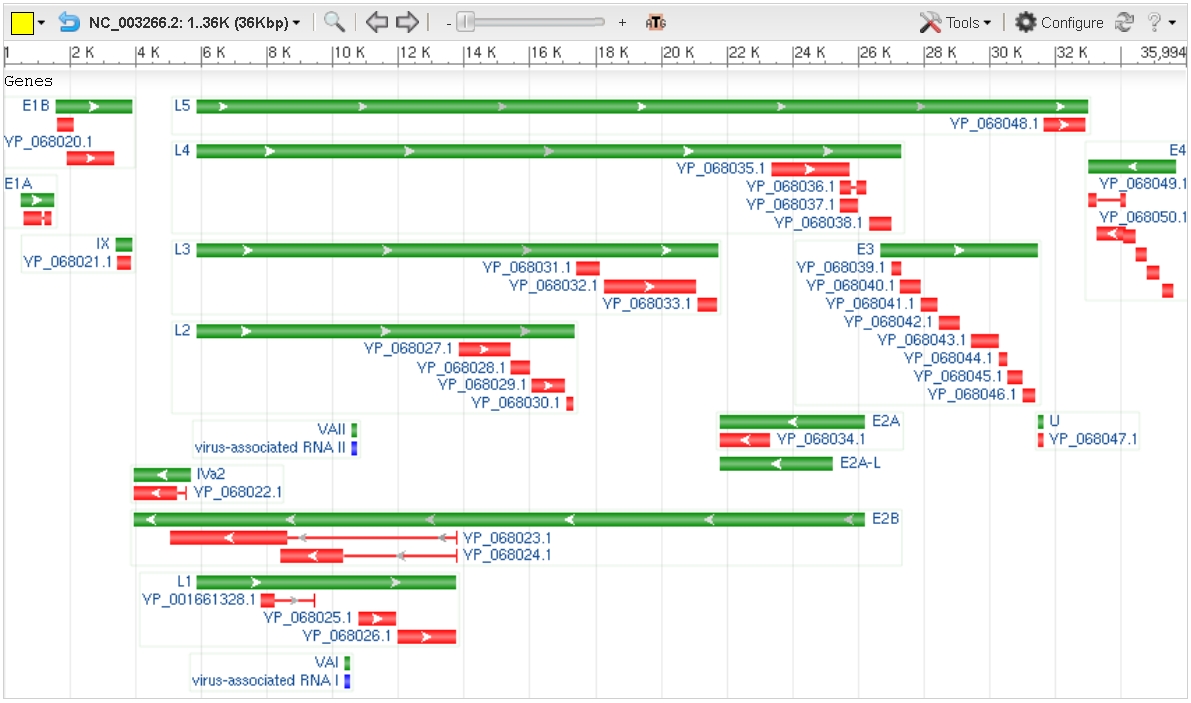Adenovirus Genome on:
[Wikipedia]
[Google]
[Amazon]
 The 38 genes in the Human
The 38 genes in the Human
Adenovirus
Adenoviruses (members of the family ''Adenoviridae'') are medium-sized (90–100 nm), nonenveloped (without an outer lipid bilayer) viruses with an icosahedral nucleocapsid containing a double-stranded DNA genome. Their name derives from the ...
genome
In the fields of molecular biology and genetics, a genome is all the genetic information of an organism. It consists of nucleotide sequences of DNA (or RNA in RNA viruses). The nuclear genome includes protein-coding genes and non-coding ge ...
s are linear, non-segmented double-stranded (ds) DNA molecules that are typically 26-46 Kbp long, containing 23-46 protein-coding gene
In biology, the word gene (from , ; "...Wilhelm Johannsen coined the word gene to describe the Mendelian units of heredity..." meaning ''generation'' or ''birth'' or ''gender'') can have several different meanings. The Mendelian gene is a ba ...
s. The example used for the following description is Human adenovirus E, a mastadenovirus
''Mastadenovirus'' is a genus of viruses in the family ''Adenoviridae''. Humans and other mammals serve as natural hosts. There are 51 species in this genus. The genus as a whole includes many very common causes of human infection, estimated to ...
with a 36 Kbp genome containing 38 protein-coding genes. While the precise number and identity of genes varies among adenoviruses, the basic principles of genome organization and the functions of most of the genes described in this article are shared among all adenoviruses.
Transcription units
 The 38 genes in the Human
The 38 genes in the Human adenovirus
Adenoviruses (members of the family ''Adenoviridae'') are medium-sized (90–100 nm), nonenveloped (without an outer lipid bilayer) viruses with an icosahedral nucleocapsid containing a double-stranded DNA genome. Their name derives from the ...
E genome are organized in 17 transcription
Transcription refers to the process of converting sounds (voice, music etc.) into letters or musical notes, or producing a copy of something in another medium, including:
Genetics
* Transcription (biology), the copying of DNA into RNA, the fir ...
units, each containing 1-8 coding sequences. Alternative splicing during processing of the pre-mRNAs produced by each transcription unit enable multiple different mRNA
In molecular biology, messenger ribonucleic acid (mRNA) is a single-stranded molecule of RNA that corresponds to the genetic sequence of a gene, and is read by a ribosome in the process of Protein biosynthesis, synthesizing a protein.
mRNA is ...
s to be produced from one transcription unit.
The E1A, E1B, E2A, E2B, E3, and E4 transcription units are successively transcribed early in the viral reproductive cycle. The proteins coded for by genes within these transcription units are mostly involved in regulation of viral transcription, in replication of viral DNA, and in suppression of the host response to infection.
The L1-L5 transcription units are transcribed later in the viral reproductive cycle, and code mostly for proteins that make up components of the viral capsid or are involved in assembly of the capsid. The L1-L5 transcription units are all regulated by the same promoter region and share the same transcription start site. As a result, transcription of all five late transcription units begins at the same point in the viral reproductive cycle.
Transcription of pre-mRNAs beginning at the late promoter is randomly terminated at one of five termination sites, producing a population of transcripts of five different lengths. The pre-mRNAs of any given length are then alternatively spliced
Alternative splicing, or alternative RNA splicing, or differential splicing, is an alternative splicing process during gene expression that allows a single gene to code for multiple proteins. In this process, particular exons of a gene may be in ...
to produce 1-4 different mRNAs coding for a corresponding number of proteins.
Protein-coding genes
The names, locations, and properties of the 38 protein-coding genes in the Human Adenovirus E genome are given in the following table. The functions of many adenovirus proteins are known: * Structural proteins include capsid proteins II ( hexon), III (penton base), IIIa, IV (fiber), VI, VIII, and IX; and core proteins V, VII, X, and the terminal protein TP. * Encapsidation proteins IVa2, 52K, and L1, and hexon assembly protein 100K are involved in assembly of viral capsids. * The L3 protease cleaves viral precursor proteins pTP, pVI, pVII, pVIII, and IIIa to produce the mature viral proteins. * Control protein E1A activates transcription of a number of viral genes as well as genes of the host cell. * Control protein E1B 19K suppresses apoptosis by mimicking the action of cellular protein Bcl-2. * Control protein E1B 55K binds to and inactivates the transcriptional regulator p53, thus blocking transcription of genes normally activated by p53 and contributing to the suppression of apoptosis. * The three proteins coded for by the E2A and E2B transcription units are all involved in replication of viral DNA. Adenovirus DNA replication begins at each end of the viral DNA, using the TP protein (rather than RNA) as a primer, so the viral DNA polymerase replicates every base of the genome. * Membrane protein E3 RID-alpha and membrane protein E3 RID-beta performs a variety of molecular functions that contribute to inhibiting apoptosis. * CR1 beta membrane glycoprotein modulates the host immune response. * Membrane glycoprotein E3 gp19K inhibits the insertion of class I MHC proteins in the host-cell membrane, thereby preventing T-cell lymphocytes from recognizing that the host cell has been infected by a virus. * Control protein E3 14.7K protects the virus from host antiviral responses. * The control proteins of the E4 transcription unit are involved in regulating transcription of viral DNA.References
{{Reflist Adenoviridae Genomics Animal virology